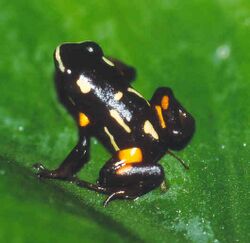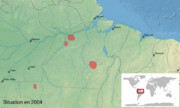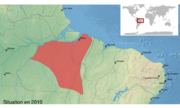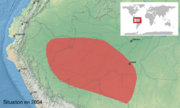Biology:Adelphobates
| Adelphobates | |
|---|---|

| |
| Adelphobates castaneoticus | |
| Scientific classification | |
| Domain: | Eukaryota |
| Kingdom: | Animalia |
| Phylum: | Chordata |
| Class: | Amphibia |
| Order: | Anura |
| Family: | Dendrobatidae |
| Subfamily: | Dendrobatinae |
| Genus: | Adelphobates Grant et al., 2006[1] |
| Type species | |
| Adelphobates castaneoticus (Caldwell and Myers, 1990)
| |
| Species | |
|
3 species (see text) | |
Adelphobates is a small genus of poison dart frogs. They are found in the central and lower Amazon basin of Peru and Brazil, possibly Bolivia.[2] It was originally erected as a sister group to the Dendrobates and Oophaga genera.[1] The validity of the genus is still being discussed, with the alternative being "Dendrobates galactonotus group" within Dendrobates.[2] One species originally placed in this genus as Adelphobates captivus has since been moved to the genus Excidobates erected in 2008.[3]
Etymology
Adelphobates is from the Ancient Greek, adelphos (brother or twin) and bates (walker or climber)."Brothers" refers to Charles W. Myers and John W. Daly, two unrelated scientists directly involved with studies of the species.[1]
Biology
All members have conspicuous, vibrant coloration, and smooth skin.[1] A peculiar feature of their reproduction is that tadpoles are transported to Brazil nut capsules lying on the forest floor. Cannibalism may result if more than one tadpole ends up in the same capsule.[4]
Poison
All poison frogs are toxic and noxious. Like frogs of the genus Dendrobates, Adelphobates contain Pumiliotoxin 251D, which is hydroxylated to Allopumiliotoxin 267A, which is 5 times more toxic. The median lethal dose is 200 µg/kg and 40 µg/kg respectively.[5][6]
Species
There are three species:[2][7]
| Common name | Scientific name and subspecies | Range | Size and ecology | IUCN status and estimated population |
|---|---|---|---|---|
| Brazil-nut poison frog | Adelphobates castaneoticus (Caldwell and Myers, 1990) |
State of Pará in Brazil
|
Size: Habitat: Diet: |
LC
|
| Splash-backed poison frog or splashback poison frog | Adelphobates galactonotus (Steindachner, 1864) |
Southern Amazon Basin in Brazil.
|
Size: Habitat: Diet: |
LC
|
| Amazonian poison frog | Adelphobates quinquevittatus (Steindachner, 1864) |
Southern Amazon Basin in Brazil and Bolivia.
|
Size: Habitat: Diet: |
LC
|
References
- ↑ 1.0 1.1 1.2 1.3 Grant, Taran; Frost, Darrel R.; Caldwell, Janalee P.; Gagliardo, Ron; Haddad, Célio F.B.; Kok, Philippe J.R.; Means, D. Bruce; Noonan, Brice P. et al. (2006). "Phylogenetic systematics of dart-poison frogs and their relatives (Amphibia: Athesphatanura: Dendrobatidae)". Bulletin of the American Museum of Natural History 299: 1–262. doi:10.1206/0003-0090(2006)299[1:PSODFA2.0.CO;2]. http://digitallibrary.amnh.org/dspace/bitstream/2246/5803/1/B299.pdf.
- ↑ 2.0 2.1 2.2 Frost, Darrel R. (2014). "Adelphobates Grant, Frost, Caldwell, Gagliardo, Haddad, Kok, Means, Noonan, Schargel, and Wheeler, 2006". Amphibian Species of the World: an Online Reference. Version 6.0. American Museum of Natural History. http://research.amnh.org/vz/herpetology/amphibia/Amphibia/Anura/Dendrobatidae/Dendrobatinae/Adelphobates. Retrieved 13 September 2014.
- ↑ Frost, Darrel R. (2014). "Excitobates Twomey and Brown, 2008". Amphibian Species of the World: an Online Reference. Version 6.0. American Museum of Natural History. http://research.amnh.org/vz/herpetology/amphibia/Amphibia/Anura/Dendrobatidae/Dendrobatinae/Excidobates. Retrieved 13 September 2014.
- ↑ Vitt, Laurie J.; Caldwell, Janalee P. (2014). Herpetology: An Introductory Biology of Amphibians and Reptiles (4th ed.). Academic Press. p. 490.
- ↑ Daly, John W.; Ware, Nathaniel; Saporito, Ralph A.; Spande, Thomas F.; Garraffo, H. Martin (June 2009). "N-Methyldecahydroquinolines: An Unexpected Class of Alkaloids from Amazonian Poison Frogs (Dendrobatidae)". Journal of Natural Products 72 (6): 1110–1114. doi:10.1021/np900094v. ISSN 0163-3864. PMID 19432407.
- ↑ Schulte, Bruce A.; Goodwin, Thomas E.; Ferkin, Michael H. (2015-12-09) (in en). Chemical Signals in Vertebrates 13. Springer. ISBN 978-3-319-22026-0. https://books.google.com/books?id=ocIvCwAAQBAJ&q=allopumiliotoxin+267a+ld50&pg=PA312.
- ↑ "Dendrobatidae". AmphibiaWeb: Information on amphibian biology and conservation. [web application]. Berkeley, California: AmphibiaWeb. 2014. http://www.amphibiaweb.org/lists/Dendrobatidae.shtml. Retrieved 13 September 2014.
External links
Wikidata ☰ Q138042 entry
 |




